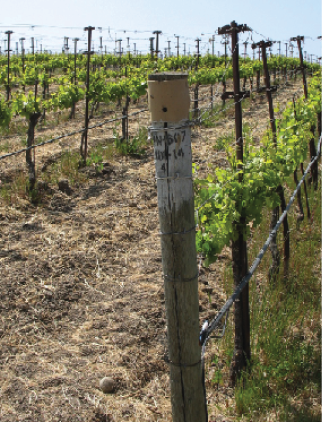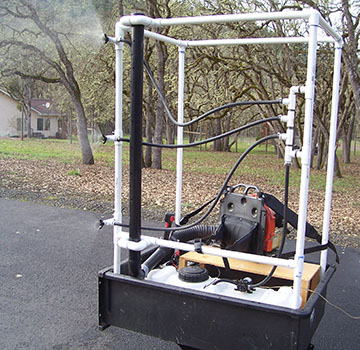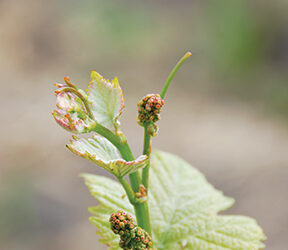 We all have worries when it comes to our vineyards. As we walk through our rows we often ignore the perfectly balanced vines or the parts of the canopy that have a perfectly uniform distribution of fruit. I’ve mentioned before in this column how we always see the problems at the margins of our vineyards.
We all have worries when it comes to our vineyards. As we walk through our rows we often ignore the perfectly balanced vines or the parts of the canopy that have a perfectly uniform distribution of fruit. I’ve mentioned before in this column how we always see the problems at the margins of our vineyards.
My struggle, as I sit down to write this article in the midst of an excellent harvest here at Clos Pepe Vineyards, Santa Barbara County, is that our consulting weatherman has called for a slight to moderate heat wave that will start in about three days. With most of the vineyard still laden with tiny, indigo clusters of Pinot Noir and slightly larger golden clusters of Chardonnay, it makes me feel nervous that everything will be ripe (or even slightly overripe) once things cool down again next week.
The forecast for hot days happens every vintage, and every year I lose a few nights sleep as the hamster wheel in my brain starts counting red and white barrels that I think are in the winery, yeasts in the fridge, press dates, managing employees and crews. I explain my anxiety to my wife as being an intense desire to make really good wine. We worry because we care. And we care because we love wine.
And in that vein, we jump right into your concerns about growing good wine in our backyards and small-scale vineyards. Hope everyone had a great harvest, and this discussion leads you to grow better wines.
Hans-Christian Holdt from Oslo, Norway asks via email:
I read that a Merlot leaf would reach the size of a man’s hand. My Pinots, which then should be smaller, have leaves up to 15 inches (38 cm) across. The branch is 7 inches (18 cm) between leaves, so it seems way too large. When it comes to leaf angle its close to horizontal, between 150 to almost 180 degrees to the leaf stem. I conclude that the vine is overfed and overdrunk! And this growth is at 60 North during a rather cold summer.
So why? Well, I admit I did fertilize both last summer and again this spring, first with a bone fertilizer and then with horse manure. The soil is also high in clay and the Pinot is on its natural rootstock. Rainfall this summer has been above average (100 mm, or nearly 4 inches, in June), and on top of that it gets a daily dose of sun-warmed water in the evening. All things taken together seem to indicate we’re way out of balance here. Growth looks very good, however, with grapes up to 15mm (1⁄2 inch) across by mid-August.
Except, lately some few grapes have started to turn brown and rot. I’ve never seen this before and it even happens to the unfinished green grapes. There is no visible fungus or things to indicate one grape is infecting another. So now I wonder, can this be due to stress from too much water and nutrients?
Wes responds to Hans-Christian:
There are a few questions here and I will try to address each in turn. Proper nutrient status for a vineyard produces cane growth between 3 to 5 feet (1 to 1.5 m) per shoot, and leaves that are a matte green, not shiny and waxy. The size of the leaves, the obtuse angle of the leaf blade to the petiole, and the extraordinary intermodal length (nodes should be about 3 to 4 inches (7 to 10 cm) between, and the incidence of “water berry” (my diagnosis of your issue) are shouting to me: too much nitrogen! Water berry is usually diagnosed as a vine’s reaction to elevated levels of nitrogen that is available. The same disease is known in distant locales as “bunch stem necrosis” (Australia), “palo negro” (Chile), “shanking” (New Zealand), “Stiellahme” (Germany), and “dessechement ed al rafle” (France). I fear that you simply overfertilized this vineyard, and I recommend never fertilizing a vineyard unless it is too stunted to produce a 12–15 leaf-to-cluster ratio.
So you may see this every year if the soil is too nitrogen rich for grapevines, but my recommendation is to stop fertilizing and see if the vine comes into balance in the next few vintages. Normal recommendation is to cut the affected berries off the clusters if the incidence is low enough to take care of that. Impacted berries will not ripen, and will add a lot of bad, green flavors to the wine.
Tom Riley of Yucaipa, California writes:
I seem to have a problem with some of my grapes drying out like raisins, while others on the same vine are plump. I grow red
wine grapes including Cabernet, Zinfandel and Merlot. What’s the cause?
Wes responds:
I will admit I just spied on your harvest via Facebook and saw some raisining on the fruit you were putting into your crusher. I graduated from the University of Redlands, so I know Yucaipa very well.
I think you have chosen excellent varietals for the desert (Yucaipa is closer to Palm Springs than Los Angeles), and summers are brutally hot and dry. Here are a couple of possibilities to consider when having burn/raisin issues:
• Reduce leafing to allow the clusters to be protected by 1-1.5 leaf layers between the sun and the fruit. This does not mean you should leave a congested canopy, just make sure the fruit is less exposed to those 100-degree days you had almost every day in August.
• Pick earlier before the raisining begins. Assess how much raisining is occurring. If it’s less than 25% and the juice is still sweet and balanced, it may just be something to get used to. But if 30–50% or more of the fruit is raisining on the vine, you need to consider ways to harvest sound fruit. It may mean lower Brix at harvest, or even making a rosé, or you could cross over to the dark side:
• Make an Amarone-style wine and let the grapes get as raisined as you’d like.
I suspect you see the most raisining on your Zin, as it has thin skins that are prone to issues.
There’s another subject to consider too: are these raisins sweet, developed and delicious, or are they grapes that dried out before ripeness? Raisins usually develop on the outside berries that collect the most sun during daylight hours, so if this is the case, you’re just getting sunburn.
Dimpling and a bit of raisined fruit is quite common in making bigger styles of California wine, so if the raisins are delicious, I wouldn’t worry too much.
Raisins are notorious for soaking up sugar in must, so be sure that you test your must 48 hours after crush to see how far the Brix went up as the raisins slowly leak their precious sugar into solution. So if a field sample of Brix comes back 23 with raisins, you can expect to see 24–25 °Brix in a few days.
Adrean Gay writes in:
I was fortunate to buy a house with four grapevines started for me, so I am very new to this. Most things I read say not to let a trunk get over five years old. Do I need to buy new vines every few years, or will they grow if I let some grapes fall on the ground? How can I tell what kind of vines I have? Can you recommend a guide for the winemaking process? I currently have From Vines to Wines by Jeff Cox.
Wes responds:
That’s a lot of questions, let’s see what we can do to give you some direction.
First, it is near impossible to teach yourself how to farm winegrapes. Books are nice, and of course I recommend the Best of WineMaker Guide to Growing Grapes as a good jumping off point, but the only way to really learn viticulture is to work with an expert through a year. But with only four vines in the backyard, it will be very difficult to make enough wine to fill a vessel, especially when you don’t know if you have table grapes or winegrapes.
I personally would eat the grapes or find another home winemaker and try to fold your grapes into his/her production and get a few bottles of wine back from them.
Grapevine trunks last as long as most trees — 220 years is about the record for a producing grapevine’s life, so your vines are like owning a parrot or a tortoise — they could easily outlast you. Pruning is a different story. The easiest way to prune is using a spur system. There are lots of YouTube videos on pruning that you can watch, or hire a pro pruner to do it the first year and watch closely and take notes or capture it on video.
Proper pruning and trellising will keep fruit off the ground, where it really doesn’t belong. Cluster height should be between 2–5 feet (~1–1.4 m) off the vineyard floor, aka the backyard. The vines may need a simple stake and wire trellis system to support themselves.
As far as what you have planted, my first recommendation would be to contact the previous homeowners and see if they remember. You can send tissue to an ampelographer for testing, or just be happy with what you have, keep the vines producing more and more fruit, and try eating the grapes, making jam, making rosé or regular wine and see what works best.
Alison Crowe’s Winemaker’s Answer Book is an excellent resource for all questions, newbie and professional (I use it every harvest at least once!). Making wine is like playing poker or the piano — you’re not going to win the World Series or play Carnegie Hall the first year. There’s a reason why some winemaking families go back five generations or more — it’s a long, slow learning curve to be able to make drinkable wine.
So my final suggestion to you is to be patient and let the vines start speaking to you. You will learn when and how much to water, how to prune for balance and crop level, what the fruit tastes like at different stages of ripeness. Make some bad wine, some good jam, or just try to keep the raccoons out. Either way you’re in for a fun journey in your new relationship with your backyard vines.
Henry Urick from Castaic, California writes:
Normal harvest dates here are in August, but the heatwave this year in August caused some leaf burn to my Cabernet vines. They are coming back but the fruit remains stuck at 19–21 °Brix. I decided to wait it out. I assume it will eventually get to 25 like it has in the past. Will the extra hang time be good?
Wes says:
Without some pictures of how the vines look, it’s difficult to assess the vine’s ability to use green leaves to absorb sunlight, produce photosynthesis, and help the grapes continue to ripen and produce mature flavors. You can dehydrate fruit on a defoliated vine to 25 °Brix, but the wine will not taste the same as if healthy green leaves produced an evolution of flavors.
Leaves, even in hot arid regions, rarely burn and fall off. Was there sulfur on the leaves when the heat event happened that killed the leaves? Sulfur can be toxic to vines if temperatures are in the extreme hot range. In a place hot and arid like Castaic, be very careful what you spray and make sure there are no hot weather toxicity issues with those products.
You said the vines came back, so I’m assuming you have some lateral shoots popping out and starting to give you some fresh, green leaves again. That’s great. Now you may have to adjust the crop. Dropping fruit to make a 12-15 leaves per cluster ratio on each vine (yes you have to count) would make sure the vine doesn’t give up with its limited amount of vigor from a few leaves.
Take home message. Find out how your leaves burned off and make adjustments to your practices to keep that from happening again. Next adjust the leaf to cluster ratio so the remaining fruit will evolve and make great wine.







